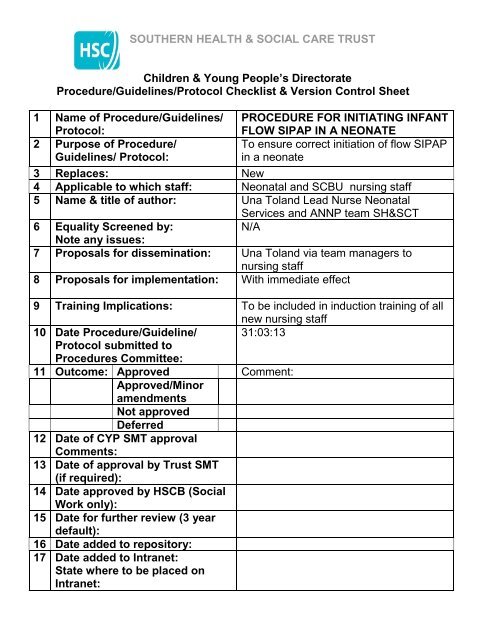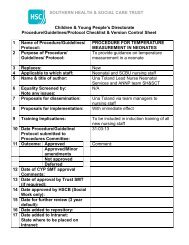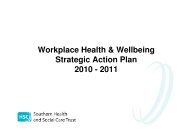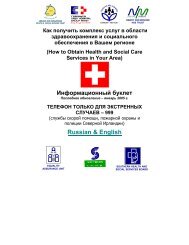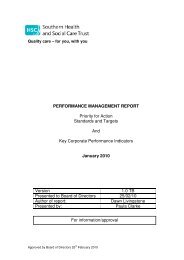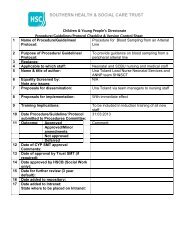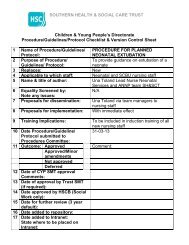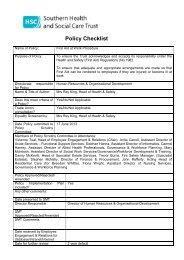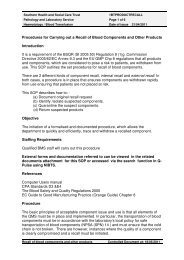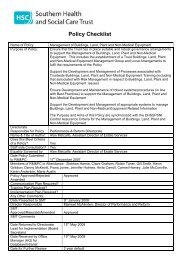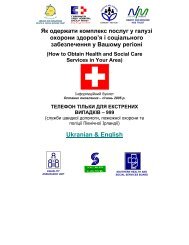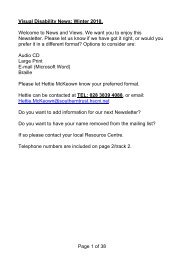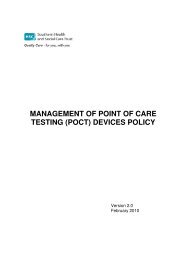Initiating Infant Flow SIPAP - Southern Health and Social Care Trust
Initiating Infant Flow SIPAP - Southern Health and Social Care Trust
Initiating Infant Flow SIPAP - Southern Health and Social Care Trust
Create successful ePaper yourself
Turn your PDF publications into a flip-book with our unique Google optimized e-Paper software.
SOUTHERN HEALTH & SOCIAL CARE TRUST<br />
Children & Young People’s Directorate<br />
Procedure/Guidelines/Protocol Checklist & Version Control Sheet<br />
1 Name of Procedure/Guidelines/<br />
Protocol:<br />
2 Purpose of Procedure/<br />
Guidelines/ Protocol:<br />
PROCEDURE FOR INITIATING INFANT<br />
FLOW <strong>SIPAP</strong> IN A NEONATE<br />
To ensure correct initiation of flow <strong>SIPAP</strong><br />
in a neonate<br />
3 Replaces: New<br />
4 Applicable to which staff: Neonatal <strong>and</strong> SCBU nursing staff<br />
5 Name & title of author: Una Tol<strong>and</strong> Lead Nurse Neonatal<br />
Services <strong>and</strong> ANNP team SH&SCT<br />
6 Equality Screened by:<br />
N/A<br />
Note any issues:<br />
7 Proposals for dissemination: Una Tol<strong>and</strong> via team managers to<br />
nursing staff<br />
8 Proposals for implementation: With immediate effect<br />
9 Training Implications: To be included in induction training of all<br />
new nursing staff<br />
10 Date Procedure/Guideline/ 31:03:13<br />
Protocol submitted to<br />
Procedures Committee:<br />
11 Outcome: Approved Comment:<br />
Approved/Minor<br />
amendments<br />
Not approved<br />
Deferred<br />
12 Date of CYP SMT approval<br />
Comments:<br />
13 Date of approval by <strong>Trust</strong> SMT<br />
(if required):<br />
14 Date approved by HSCB (<strong>Social</strong><br />
Work only):<br />
15 Date for further review (3 year<br />
default):<br />
16 Date added to repository:<br />
17 Date added to Intranet:<br />
State where to be placed on<br />
Intranet:
SOUTHERN HEALTH & SOCIAL CARE TRUST<br />
PROCEDURE FOR INITIATING INFANT FLOW <strong>SIPAP</strong> IN A<br />
NEONATE<br />
Statement: To provide a non-invasive form of continuous positive airway<br />
pressure to babies with respiratory difficulties.<br />
Equipment: <strong>Infant</strong> flow <strong>SIPAP</strong>, MR290 humidification chamber<br />
Circuits<br />
Nasal prong / mask (size appropriate)<br />
<strong>SIPAP</strong> hat (size appropriate)<br />
Hat measuring tape<br />
1 litre bag of sterile Water <strong>and</strong> extension set<br />
ACTION<br />
Where possible parents should be<br />
informed of planned procedure<br />
Decontaminate h<strong>and</strong>s as per local policy<br />
adhering to 7 step technique <strong>and</strong> 5<br />
moments of h<strong>and</strong> hygiene.<br />
Ensure infant flow <strong>SIPAP</strong> has been<br />
decontaminated <strong>and</strong> functionally checked.<br />
RATIONALE<br />
To gain consent <strong>and</strong> cooperation<br />
To reduce risk of cross contamination<br />
To prevent the risk of cross infection.<br />
Plug into mains <strong>and</strong> connect air <strong>and</strong><br />
oxygen connections to supply.<br />
Carry out two point oxygen calibration as<br />
per manual.<br />
Carry out low <strong>and</strong> high airway pressure<br />
alarm as per manual <strong>and</strong> set pressures as<br />
prescribed.<br />
Adjust % oxygen control as prescribed.<br />
To provide electric supply <strong>and</strong> gases to<br />
equipment.<br />
To ensure correct oxygen concentration is<br />
delivered to the baby.<br />
To ensure correct pressure is delivered to<br />
baby. Also to ensure correct oxygen <strong>and</strong><br />
carbon dioxide exchange.<br />
To ensure correct oxygen concentrations.
SOUTHERN HEALTH & SOCIAL CARE TRUST<br />
Use disposable self-filling humidifier tubing<br />
with 1 litre of sterile water <strong>and</strong> attach to<br />
MR290 humidifier. Temperature of<br />
humidifier must be set between 36oc <strong>and</strong><br />
never higher than 37 o c.<br />
Measure for prong / mask size using the<br />
measurement guide provided.<br />
Measure for bonnet size using the<br />
measuring colour coded tape provided.<br />
Measure from middle of the forehead to<br />
the nape of the neck <strong>and</strong> then back to the<br />
middle of the forehead.<br />
Loosely weave generator straps through<br />
the bonnet holes.<br />
Place bonnet onto baby’s head checking<br />
that the ears are in a normal position. Pull<br />
down well over ears <strong>and</strong> down to the nape<br />
of the neck.<br />
Lift the generator from the top of the<br />
bonnet <strong>and</strong> bring towards the nose. Gently<br />
insert the nasal prongs / mask into the<br />
nasal airways.<br />
Secure the straps horizontally across the<br />
cheeks <strong>and</strong> do not tighten.<br />
Secure all three tubes from generator with<br />
the central Velcro strap. Split the<br />
inspiratory <strong>and</strong> pressure lines <strong>and</strong> secure<br />
with secondary Velcro straps. Tie the<br />
open end of the bonnet if desired. Ensure<br />
nose is in neutral position, eyes visible <strong>and</strong><br />
ears not folded.<br />
Ensure tubing with humidification<br />
temperature probe is situated at grommet<br />
of the incubator door.<br />
Loosen the generator straps <strong>and</strong> release<br />
the tubes from the central Velcro strap<br />
every 3-4 hours <strong>and</strong> clean the nasal area<br />
with sterile water.<br />
To ensure adequate humidity to prevent<br />
drying of secretions <strong>and</strong> to ensure patency<br />
of nasal airway.<br />
To ensure correct positioning of nasal<br />
prong / or mask. To prevent nasal<br />
irritation, septal distortion, skin irritation<br />
<strong>and</strong> pressure necrosis.<br />
To provide correct pressures <strong>and</strong> oxygen.<br />
To prevent nasal irritation, septal distortion,<br />
skin irritation <strong>and</strong> pressure necrosis.<br />
To ensure bonnet is situated securely <strong>and</strong><br />
comfortably.<br />
To prevent nasal irritation, septal<br />
distension, skin irritation <strong>and</strong> pressure<br />
necrosis.<br />
To prevent septal distension.<br />
To ensure adequate delivery of oxygen<br />
<strong>and</strong> pressures. To prevent pressure<br />
necrosis.<br />
To prevent the accumulation of water that<br />
causes condensation in tubing.<br />
To ensure patency of nasal airways, to<br />
prevent build-up of mucous.
SOUTHERN HEALTH & SOCIAL CARE TRUST<br />
Record hourly oxygen concentration levels<br />
CPAP pressures delivered <strong>and</strong><br />
humidification temperature.<br />
Monitor blood gases as directed by<br />
attending Consultant/ANNP<br />
If infant is nursed on continuous <strong>SIPAP</strong>.<br />
The circuit should be changed every seven<br />
days. Change the nasal prong insert every<br />
day.<br />
After use ensure equipment is<br />
decontaminated as per manufacturer’s<br />
instructions.<br />
To ensure correct oxygen, pressures <strong>and</strong><br />
humidification temperature is delivered to<br />
baby.<br />
To ensure adequate oxygen <strong>and</strong> carbon<br />
dioxide gas exchange <strong>and</strong> to facilitate<br />
weaning.<br />
To minimise the risk of cross infection.<br />
Some bacteria which colonise the nasal<br />
passages produce large amounts of<br />
mucous. Changing of nasal prongs daily<br />
reduces build-up of bacterial colonisation<br />
of nasal passages.<br />
To ensure the prevention of cross<br />
infection.<br />
March 2013<br />
References :<br />
Newborn services clinical guidelines (2010)<br />
www.adhb.govt.nz/newborn/guidelines/respiratory/CPAP/CPAPSetup.htm


